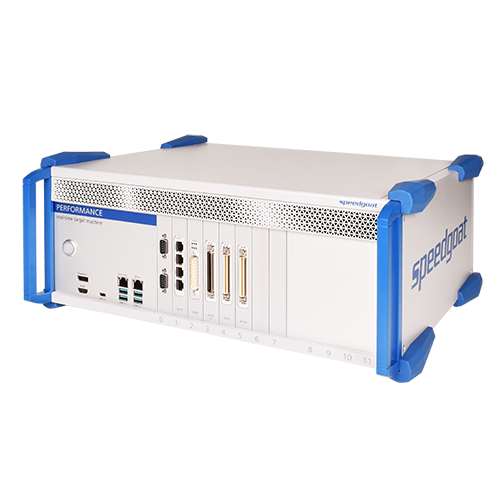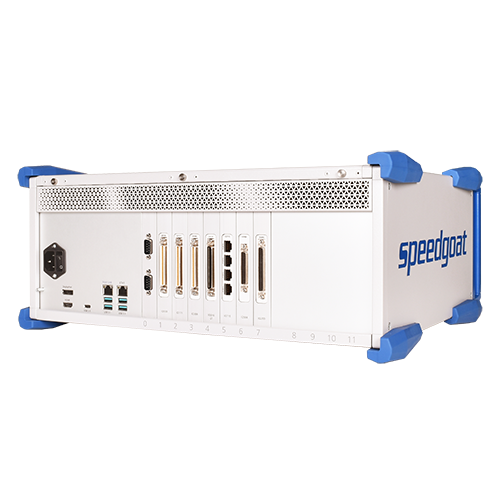Performance Real-Time Target Machine
The Performance real-time target machine is Speedgoat’s mainstay target computer for office and lab use and can be placed on a desk or installed in a rack.
It is used in a broad range of application areas and industry sectors, such as vision and image processing, rapid control prototyping or plant simulation with hardware-in-the-loop (HIL).
MathWorks software products are optimised to guarantee the best real-time performance, workflow integration and usability with Simulink Real-Time™ and Speedgoat target machines.
Speedgoat builds and optimises its target machines for use with Simulink Real-Time, as well as guaranteeing that each target machine is configured to meet specific requirements, such as sample rate, I/O, and environmental.
Every target machine comes with Simulink driver blocks or FPGA reference designs to configure all installed I/O and protocols functionality. Simulink test models are also provided.
Real-time target machines with Intel i3 and i7 CPUs with clock speed up to 4.2 GHz are made for hard real-time execution, where reaction times are fully deterministic. With multicore, multi-target, and FPGA-based hardware and software technologies provided by MathWorks and Speedgoat closed-loop sample rates up to several MHz are achievable.
- Concurrent real-time application execution on multiple cores, target machines, and FPGAs
MathWorks software (including Simulink Real-Time, MATLAB Coder, Simulink Coder, and HDL Coder), Speedgoat real-time target machines and FPGA-based I/O modules allow concurrent execution of your real-time application created from Simulink models on multiple cores, target machines, and FPGAs.
- Multicore execution
The Performance real-time target machine comes with multicore Intel CPUs ranging from a two core Intel Core i3 CPU to a 20-core system with dual Intel Xeon CPUs. This combined with Simulink Real-Time technology to automatically distribute performance optimised models to multiple cores allows application execution times to be significantly reduced, especially for complex models.
- Multi-target execution
Using fiber-optic or Ethernet-based communication links between multiple real-time target machines, execution of real-time applications can be split across many systems. Given the low synchronisation latency of fiber-optic links, multiple high clock-rate, multi-core, real-time target machines provide superior performance compared to lower clocked multicore Xeon CPUs. Application execution on multiple cores is most suitable for real-time applications created from very complex Simulink designs. Shared memory I/O modules are the best way to do this.
- FPGA co-execution
Xilinx FPGA-based I/O modules from Speedgoat, combined with HDL Coder from MathWorks, and x86/FPGA co-execution functionality provided by Simulink Real-Time, provide you with a seamless workflow to automatically generate, run, verify, and validate parts of your real-time application on one or several FPGAs.
Using powerful high-bandwidth bus solutions, connecting several FPGA-based I/O modules, Simulink designs can be partitioned to execute across multiple FPGAs. This enables execution of very complex applications requiring hundreds of analog and digital I/O channels at closed-loop sample rates of up to several MHz.
The Performance real-time target machine can support a vast range of I/O to connect with your hardware. It comes with some I/O preinstalled on-board, and a large range of additional functionality can be added in the form of I/O modules. Up to 12 I/O modules can be installed directly into the target machine. More than 50 can be used with the flexible expansion concept.
I/O Modules
Speedgoat I/O modules offer an easy, flexible way of adding a large variety of I/O to your real-time target machine.
On-board I/O Connectivity
The following I/O comes pre-installed as standard in every Performance real-time target machine:
- 1 x Ethernet port supporting XCP Slave and Host-Target communication
- 1 x Ethernet port supporting EtherCAT Master, real-time UDP and XCP Master over UDP (level of support varies depending on MATLAB version).
- 1 x Ethernet port supporting PTP 1588 (except Core and Core+)
- 1 x RS232/422/485 at front
- 1 x RS232/422/485 internal
- 4-6 USB 3.0 at front or internal
- 2-8 USB 2.0 at front or internal
The enclosure of the Performance real-time target machine is manufactured from high-grade aluminum which is ideal as it is strong, very light, corrosion resistant, conducts heat and is non-magnetic. The front is anodized while all other panels including rear panel are powder-coated.
Enclosure options
The Performance real-time target machines are fully compatible with 19” rack mounting for laboratory and industrial use. While the width is fixed by the standard 19″, there are four enclosure options depending on the depth, height, and access to the I/O modules.
- Compact 4U enclosure (standard & Core)
The default enclosure for both the standard and Core Performance real-time target machines with the I/O modules being accessible at the front. It can be fitted with up to 7 half-length I/O modules.
- Deep 4U enclosure with front I/O access (standard & Core)
An optional enclosure for the standard and Core Performance real-time target machines with an increased depth of 440 mm to allow the installation of up to 7 full-sized PCI I/O modules accessible at the front, and up to 10 DIN-rail mountable conditioning modules.
- Deep 4U enclosure with rear I/O access (standard, Core & Core+)
The standard enclosure for the 20-core Core+, and an optional enclosure for the standard and Core Performance real-time target machines with an increased depth of 440 mm to allow the installation of full-sized PCI I/O modules accessible from the rear, and up to 10 DIN-rail mountable conditioning modules.
- Deep 5U enclosure (Type PCIe+)
This 5U (5HE) enclosure allows up to 12 I/O modules for the PCIe+ Performance real-time target machine, with the I/O modules being accessible from the rear. This is the same enclosure used by the expansion units. The latter can accommodate up to 17 additional I/O modules.
In addition to the I/O modules mounted within the housing of the Performance real-time target machine, more can be used by the addition of up to two expansion units, each providing up to 16 PCIe slots.
The Performance real-time target machine and the expansion unit are connected via a high-bandwith, low-latency Infiniband® link. Access latency to the I/O modules is increased by only 10% compared to with I/O modules plugged directly into the Performance real-time target machine itself. The I/O modules in the expansion units are detected and usable as if they were plugged into the Performance real-time target machine itself. Each expansion unit requires one PCIe I/O slot of the Performance real-time target machine.
To install more I/O modules than are possible with two expansion units please contact us to discuss further options.





